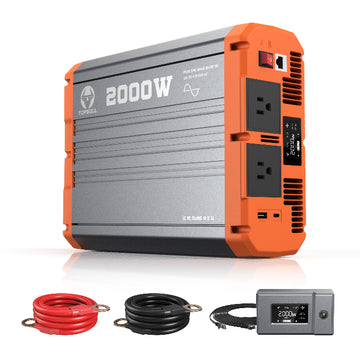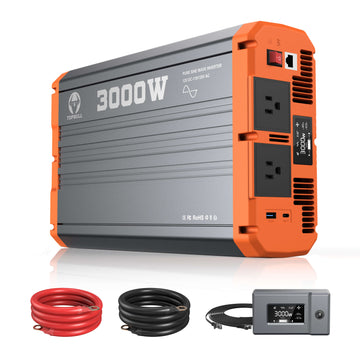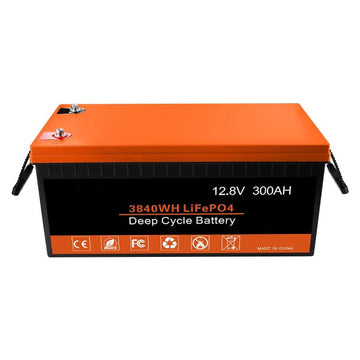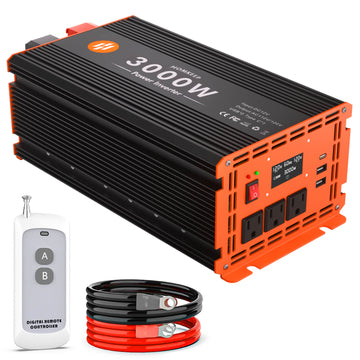As an important power conversion device, inverters are widely used in homes, automobiles and outdoor settings. Many users may have a 24V battery and wish to purchase a 12V inverter to power their equipment. In such cases, a common question is: Can I run a 12V inverter on a 24V battery?
It is not feasible to connect a 12V inverter directly to a 24V battery. 12V inverters are designed to accept an input voltage of 12V, while 24V is clearly beyond their operating range. 12V inverters cannot withstand a 24V input, which can lead to damage to the inverter, or even safety hazards such as short circuits and fires.
Consequences of Voltage Mismatch
Inverter Working Principle
An inverter converts DC power to AC power by means of a high-frequency switching circuit (e.g. MOSFET, IGBT). Its input voltage needs to be matched with the battery system (e.g. 12V or 24V), while the output provides square wave, modified wave or pure sine wave according to the demand.
Consequences of Voltage Mismatch
Hardware Damage: The 12V inverter's internal capacitors, MOSFETs and other components are designed to withstand a voltage of 12V ±10% (i.e. 10.8V-13.2V).
A 24V input will result in:
-
Capacitor breakdown: Insufficient voltage withstanding of electrolytic capacitors, leading to leakage or explosion;
-
MOSFET burnout: Gate-source voltage exceeds the rated value, leading to a permanent short circuit.
- Risk of fire: overload current may melt the circuit board copper foil and even trigger thermal runaway of the battery.
Alternative solutions
1. Voltage conversion devices
DC-DC buck converter: reduces 24V to 12V with approx. 96% efficiency (4% losses). For example, only 20W of additional heat dissipation is required for a 500W load.
Transformer: suitable for high power scenarios (e.g. above 3kW), but large size, high cost, and requires additional rectifier circuit.
2. Replace the matching equipment
Buy 24V inverter directly. Note:
-
Output waveform: pure sine wave inverter is suitable for precision equipment (e.g. computers), square wave/corrected wave inverter is suitable for motor loads;
- Power matching: select power according to the load demand, e.g. microwave ovens need more than 1,500W, and cell phone charging only needs 500W.
3. Battery pack adjustment
Parallel modification: connect two 12V batteries in parallel for 12V system (professional modification is required to avoid short-circuiting);
Series connection Use: If the device supports 24V input, you can directly connect the batteries in series.
“Inverter input voltage ≡ battery output voltage” is the core principle of the alternative. Direct voltage matching is the best option, using 12v batteries for 12v inverters and 24v batteries for 24v inverters. If this is not possible, it can be solved by a DC-DC converter or a battery modification, provided that safety regulations are strictly adhered to.
Application Scenarios and Equipment System Selection Recommendations
When selecting an inverter and battery combination, different application scenarios and equipment requirements will directly affect the selection decision. The following are system selection suggestions for several common application scenarios:
1. Home Use
Application Scenario: Household power supply, especially in case of power outage or when using solar power system.
System Selection:
-
Inverter: Choose a 12V inverter with power between 1000W and 3000W, which can meet the needs of most small household appliances and lighting equipment.
-
Battery: Purchase a 12V battery with a capacity of 100Ah and above to ensure that sufficient power can be supplied in the event of a power outage.
Solution: If a 24V battery is used, a buck converter or specific inverter configuration is required.
2. In-vehicle systems
Application Scenario: Electric power systems for electric recreational vehicles, motorhomes or other vehicles.
System Options:
-
Inverter: Choose a small and portable 12V inverter, usually between 300W and 1500W, to ensure it can support small appliances in the vehicle (e.g. TV, fridge, etc.).
-
Battery: Use a high performance deep cycle 12V battery to ensure long life and durability.
Solution: If the vehicle system is 24V, ensure that a compatible inverter or step-down device is used.
3. Outdoor activities
Application scenarios: camping, field work or emergency power supply.
System Options:
-
Inverter: Choose a portable 12V inverter (e.g. 300W to 600W) that is easy to carry and can power mobile devices and LED lighting.
-
Battery: choose lightweight, easy to transport 12V lithium batteries with a capacity of about 50Ah, which can guarantee a long time power supply needs.
Solution: When using a 24V system, consider using a buck converter to ensure equipment compatibility.
4. Small business or equipment operation
Application Scenario: Provide power support in a small store or temporary work site.
System Options:
-
Inverter: Use a high power 12V inverter with 2000W and above to support the operation of multiple devices at the same time.
-
Battery: Use high-capacity industrial-grade 12V or 24V batteries to support commercial equipment for long periods of time.
Solution: The 24V battery system needs to be matched with an inverter that supports this voltage, or use a voltage converter to ensure stable power supply.
In all application scenarios, be sure to focus on safety when selecting equipment. Ensure that the selected inverter has overload, overheat and short-circuit protection. Also, choose certified battery and inverter equipment and make sure the battery and inverter voltages are the same to avoid potential safety hazards. We recommend Topbull's 12V high-quality inverters, which are ideal for home, car and outdoor use with their high performance and multiple protection features, ensuring safe and stable power supply for various devices.
Final Reminder
To summarize, it is not feasible to run a 12V inverter directly on a 24V battery, which can lead to inverter damage and safety hazards. However, this problem can be effectively solved by using a step-down converter, transformer or purchasing a compatible inverter. Users should carefully consider determining the safety and suitability of the equipment when selecting it to avoid potential risks.













